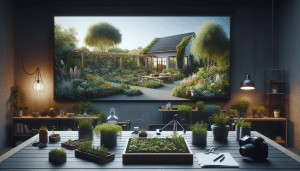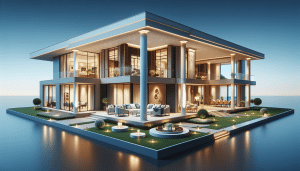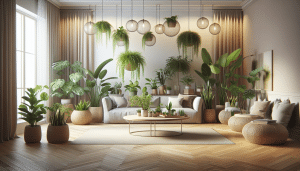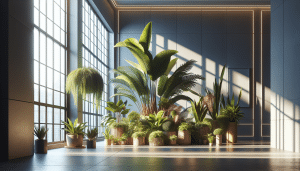Find Out How You Can Transform Any Backyard Into an Oasis
Daniel Fisher September 2, 2025
Curious about creating an outdoor retreat? This guide reveals step-by-step outdoor design ideas, sustainable gardening tips, and smart backyard solutions for all skill levels. Discover how landscaping, lighting, and eco-friendly choices can help anyone enjoy a more inviting and harmonious space at home.
Understanding the Elements of a Backyard Oasis
What really shapes a backyard oasis? Start by imagining the full sensory experience—sights, sounds, scents, and textures all contribute. Layered landscaping, soothing water features, and strategic shade structures often work together to create a sense of comfort and privacy. A well-planned backyard layout helps maximize both relaxation and functionality, whether the space is large or small. Vegetation choices, from tall evergreen hedges to lush flower beds, provide structure and visual softness. These elements can also shield the area from wind and street noise, encouraging peace and seclusion. Even simple additions like flowering shrubs and climbing vines soften fences, creating an enveloping outdoor environment. https://www.almanac.com/backyard-oasis-ideas
Hardscaping is equally vital in defining outdoor living areas. Features like patios, gravel paths, and wooden decks contribute stability, direct traffic, and segment space without overwhelming the landscape. Fine-tuned hardscape can highlight special garden features such as a small pond, fire pit, or tucked-away seating area. Consider using permeable materials like river stones or pavers with open joints to encourage drainage and support plant health. Many homeowners benefit from segmenting spaces for dining, lounging, and play—allowing family members of all ages to enjoy the backyard to the fullest. https://hgic.clemson.edu/factsheet/hardscaping-elements-for-the-landscape/
Integration of sound, movement, and fragrance can make a space feel magical. Wind chimes or small fountains introduce gentle sounds that mask neighborhood traffic. Fragrant plants, such as gardenia or lavender, release pleasant aromas at dusk, while ornamental grasses sway in the wind. These multisensory touches give a sense of life and dynamism, ensuring that each visit to the backyard feels new. Many landscape designers agree—an oasis is not just a pretty view, but an immersive, living experience that continuously delights the senses. https://extension.psu.edu/landscaping-for-well-being
Incorporating Water Features for Relaxation
Few things change the mood of a backyard like water. Whether it’s a bubbling fountain, koi pond, or a minimalist birdbath, adding water invites wildlife, cools the area, and introduces calming sounds. Water features can be as elaborate or as simple as your space allows. A small, self-contained fountain—easy to install and maintain—adds instant tranquility. Gardeners often discover that even a basic birdbath attracts pollinators and songbirds, enriching the backyard’s liveliness and offering organic pest control. https://extension.umn.edu/landscape-design/water-features-your-landscape
A pooled water source, like a small pond or reflecting pool, serves dual purposes: visual interest and microclimate moderation. Shallow ponds support water-loving plants and amphibians, while reflecting pools create meditative surfaces. Positioning a water feature near a seating area or patio ensures guests enjoy the sights and sounds as part of their overall relaxing experience. Advanced options, such as rain gardens, can help manage stormwater runoff while providing aesthetic appeal. https://www.epa.gov/green-infrastructure/green-infrastructure-design-and-implementation
Eco-friendly water features are rising in popularity. Using recirculating pumps, solar-powered fountains, or rain-harvesting barrels to fill garden ponds helps conserve water and lower utility bills. When selecting plants for aquatic environments, native options demand fewer chemicals and maintenance. Planting water lilies and native rushes works not only for beauty but promotes balanced ecosystems. With the right design, water elements create sensory richness while supporting sustainability at home. https://www.bbg.org/gardening/article/a_guide_to_backyard_ponds
Landscaping Techniques for Privacy and Comfort
Privacy in a backyard oasis begins with thoughtful landscaping. Hedges, screens, and layered planting block visual lines from neighboring homes and public spaces, making the backyard feel like a personal retreat. Fast-growing shrubs can create a green wall within a season or two, while trellises loaded with vines add vertical coverage and color. Bamboo, evergreens, or tall grasses work well for partitioning without feeling heavy or enclosed. These choices often require less ongoing maintenance than wooden or metal fencing. https://extension.okstate.edu/fact-sheets/using-plants-to-create-screening-and-privacy-in-your-yard.html
Layered landscaping designs use a mix of plant heights and textures to increase depth and visual interest. Tiering low perennials under medium-sized shrubs, and bordering them with taller trees, establishes progression from lawn to boundaries. Plants offering year-round coverage, such as holly or arborvitae, shield patios and living spaces. In smaller areas, planters and vertical gardens provide privacy while taking up less square footage. Where total privacy isn’t possible, consider lattice panels and hanging baskets to obscure sightlines and create cozy nooks.
Shade structures like pergolas, umbrellas, and fabric sails further boost comfort and create microclimates. These features offer sun protection and a place to relax during hot afternoons. Climbing vines, like wisteria or grape, can grow over arbors for filtered shade and seasonal beauty. Combined with soft outdoor seating or hammocks, shaded corners become favorite retreats. Dual-purpose garden elements, such as trellised screens with integrated seating, optimize available space and enhance a feeling of enclosure. https://hort.extension.wisc.edu/articles/creating-outdoor-rooms-privacy-screens-and-microclimates/
Sustainable Gardening for Eco-Friendly Outdoor Spaces
Sustainable gardening is key when turning any backyard into a healthy, lasting oasis. Choosing native plants helps reduce the need for excessive water, pesticides, and fertilizers, protecting local wildlife and supporting pollinators. Rain gardens and mulched beds manage water runoff and recycle nutrients back into the soil. Compost bins, built right into the garden design, make use of kitchen scraps and create a rich resource for plant health. https://www.epa.gov/soakuptherain/soak-rain-rain-gardens
Eco-friendly landscape practices include installing drip irrigation, mulching with organic materials, and lawn alternatives such as clover or low-growing ground covers. These approaches save water and decrease reliance on chemical-based lawn care. Selecting drought-tolerant foliage, like sedum or lavender, helps keep the garden lush during heatwaves. By reducing turf area and supporting diverse plantings, gardeners can better resist pests and diseases while lowering their maintenance workload. https://www.gardeningknowhow.com/special/organic/eco-friendly-garden-practices.htm
Construction choices matter as well. Use reclaimed wood, stone, or recycled materials for garden furniture and raised beds whenever possible. Solar-powered lighting and water features further lower the oasis’s environmental footprint. Many landscape designers recommend grouping plants by water needs, ensuring that no resources are wasted. Thoughtful composting and organic gardening boost soil biology and attract beneficial insects, increasing the resilience and beauty of backyard getaways. Sustainable methods not only preserve the environment but make the space feel alive year after year.
Lighting and Ambience for Evening Enjoyment
Subtle lighting transforms a backyard into an enchanting evening space. Choosing layered lighting—string lights, lanterns, spotlights, and pathway markers—adds warmth and highlights natural features after sunset. Solar and LED lights provide efficient, low-maintenance options that illuminate paths, accent trees, or cast a soft glow over seating areas. Homeowners often enjoy experimenting with the placement of lanterns or portable lights to create flexible atmospheres for gatherings or quiet relaxation. https://www.energy.gov/energysaver/landscaping-energy-efficient-homes
Lighting design shapes mood and safety. Downlights hung from pergolas or trees create pools of brightness for reading or dining, while soft ground lights keep walkways visible. Strategically positioned colored LED lights can change the space’s look for special events or themed celebrations. Safety lighting—aimed at stairs, deck edges, or pond surrounds—ensures that evening enjoyment continues without hazards. Lighting can also highlight architectural or sculptural garden details, adding new interest to familiar spaces.
Fire features extend usability into cooler seasons. Fire pits, chimineas, or tabletop fire bowls offer warmth and draw people together after dusk. Combining fire and light invites storytelling and stargazing, reinforcing the retreat-like atmosphere. Always choose safe, code-compliant materials—positioning fire features away from structures and flammable plants. Both fire and electric lighting elements come in energy-efficient models that complement an eco-conscious garden design. Smart timers or motion sensors can automate lighting, saving energy and adding convenience, so evenings are always ready for enjoyment.
Practical Layouts for Small and Large Spaces
Every backyard, regardless of size, holds potential for transformation. In smaller urban yards or patios, vertical gardens, hanging baskets, and compact furniture maximize limited space. Foldable chairs, multipurpose benches, and collapsible dining sets make flexible use of every corner. For larger plots, design often incorporates separate “rooms”—distinct areas for cooking, play, lounging, and gardening—helping the space feel organized and personalized. Even apartment balconies can be turned into mini-sanctuaries with container gardens, privacy screens, and potted trees. https://extension.uga.edu/publications/detail.html?number=B1412&title=landscaping-your-yard
Smart storage solutions and clear traffic paths are vital. Integrating garden sheds, deck boxes, or under-seat storage keeps tools and toys hidden away, reducing clutter and making maintenance simpler. Raised beds and modular planters allow efficient gardening while keeping soil and plants easy to reach. Zoning helps create logical flows between different activity zones, ensuring that cooking smoke, active games, and flower beds each remain distinct and enjoyable. Defined borders, such as low fences or decorative edging, increase coherence and focus within any yard layout.
Adaptive design strategies prioritize flexibility and accommodate changing needs. Movable screens, retractable awnings, and rolling plant containers mean the garden can evolve seasonally or as household activities shift. For families, safety surfaces—soft lawns, padded ground covers, or rubberized play tiles—make child-friendly zones, while adults may claim turf-free, low-maintenance corner for quiet reading. In every case, planning with available sunlight, soil, and wind patterns ensures success with minimal guesswork. With inspiration and practical layouts, any backyard can become a welcoming oasis that invites new memories.
References
1. The Old Farmer’s Almanac. (n.d.). Backyard Oasis Ideas. Retrieved from https://www.almanac.com/backyard-oasis-ideas
2. Clemson Cooperative Extension. (2022). Hardscaping Elements for the Landscape. Retrieved from https://hgic.clemson.edu/factsheet/hardscaping-elements-for-the-landscape/
3. Penn State Extension. (2023). Landscaping for Well-Being. Retrieved from https://extension.psu.edu/landscaping-for-well-being
4. University of Minnesota Extension. (2023). Water Features for Your Landscape. Retrieved from https://extension.umn.edu/landscape-design/water-features-your-landscape
5. United States Environmental Protection Agency. (2022). Soak Up the Rain: Rain Gardens. Retrieved from https://www.epa.gov/soakuptherain/soak-rain-rain-gardens
6. University of Georgia Extension. (2021). Landscaping Your Yard. Retrieved from https://extension.uga.edu/publications/detail.html?number=B1412&title=landscaping-your-yard








